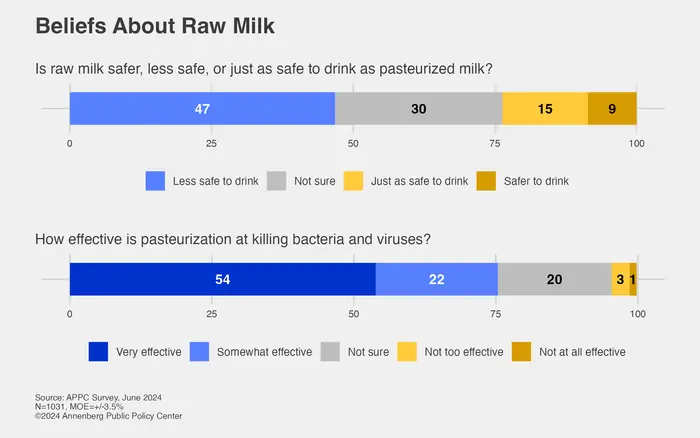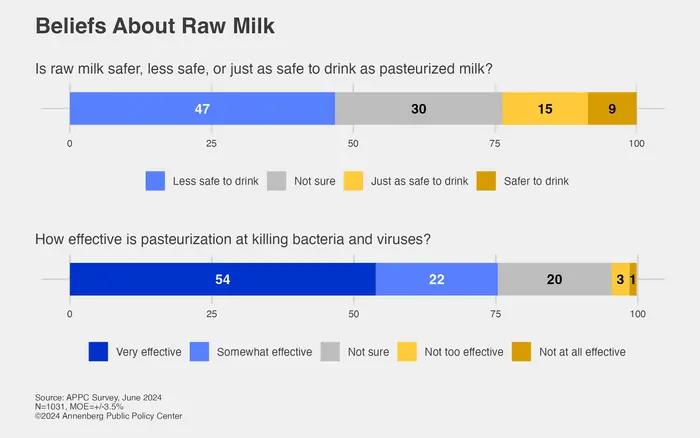PHILADELPHIA – Consuming raw milk or products made with it is riskier than drinking pasteurized milk. Yet fewer than half of U.S. adults know that drinking raw milk is less safe than drinking pasteurized milk and many Americans do not understand the risks of consuming raw milk, according to the Annenberg Public Policy Center’s latest health survey.

Credit: Annenberg Public Policy Center
PHILADELPHIA – Consuming raw milk or products made with it is riskier than drinking pasteurized milk. Yet fewer than half of U.S. adults know that drinking raw milk is less safe than drinking pasteurized milk and many Americans do not understand the risks of consuming raw milk, according to the Annenberg Public Policy Center’s latest health survey.
The survey finds that 47% percent of U.S. adults know that drinking raw milk is less safe than drinking pasteurized milk, while nearly a quarter (24%) of Americans either think incorrectly that pasteurization is not effective at killing bacteria and viruses in milk products (4%) or are not sure whether this is true (20%).
“It is important that anyone planning to consume raw milk be aware that doing so can make you sick and that pasteurization reduces the risk of milk-borne illnesses,” said Patrick E. Jamieson, director of the Annenberg Health and Risk Communication Institute at the Annenberg Public Policy Center (APPC) of the University of Pennsylvania.
APPC’s survey was conducted by SSRS, a market research company, on June 7-10, 2024, as a cross-sectional survey of 1,031 U.S. adults who are part of the SSRS Opinion Panel Omnibus. The margin of error for total respondents is ±3.5 percentage points at the 95% confidence level. (See the end of this release or the topline for further details.)
Why consuming raw milk is risky
Milk from animals including cows, sheep, and goats that has not been pasteurized to kill harmful germs is called unpasteurized or raw milk. Unpasteurized dairy products are estimated to “cause 840 times more illnesses and 45 times more hospitalizations than pasteurized products.” The Centers for Disease Control and Prevention (CDC) says that consuming unpasteurized milk and products made from it “can expose people to germs such as Campylobacter, Cryptosporidium, E. coli, Listeria, Brucella, and Salmonella.”
Heightening these concerns, the Food and Drug Administration (FDA) reported in an open letter on June 6, 2024, that bird flu has been detected in cow’s milk. Cattle infected with avian influenza “shed the virus in their milk.” Technically known as highly pathogenic avian influenza virus (HPAI) of the H5N1 subtype, the CDC has noted that H5N1 bird flu is “widespread in wild birds worldwide and is causing outbreaks in poultry and U.S. dairy cows.” The presence of H5N1 bird flu was confirmed in cattle in the United States in mid-March 2024. As of June 21, 2024, there had been four human cases of H5N1 in the United States since 2022, three in April and May of 2024 following exposure to cows and one in April 2022 following exposure to poultry. As of mid-June, 95 cattle herds in 12 states were identified as infected.
The FDA says it does not currently know whether the HPAI H5N1 virus can be transmitted to humans through consumption of raw milk and products made from raw milk from infected cows. However, a study conducted in mice concluded that the virus in “untreated milk can infect susceptible animals that consume it” and the National Institutes of Health (NIH) says this suggests that drinking raw milk “may pose a risk of transmission to people.” As of mid-June 2024, the FDA concluded “that the totality of evidence continues to indicate that the commercial milk supply [which is pasteurized] is safe.”
Although the FDA has prohibited the interstate sale of raw milk since 1987, 30 states in the United States allow the sale of raw dairy milk in some form, according to the NIH. While an FDA food safety report in 2016 said just 4.4% of U.S. adults reported consuming raw milk at least once in the past year, raw milk sales have been increasing, according to the Associated Press, which reports that weekly sales of raw milk from late March to mid-May grew from 21% to as much as 65% over the same period last year.
What people know about the risks of raw milk and benefits of pasteurization
The CDC notes that “pasteurization is crucial for milk safety, killing harmful germs that can cause illness” and the NIH says “dairy milk purchased in the grocery store has been pasteurized – heated to a level high enough and long enough to kill most viruses or bacteria in the milk.”
Yet in the APPC survey, over half of the respondents (54%) either think drinking raw milk is safer (9%), just as safe (15%), or are unsure (30%) whether it is more or less safe than drinking pasteurized milk. Nearly a quarter of those surveyed question the effectiveness of pasteurization at killing bacteria and viruses in untreated milk – 20% are unsure whether it is effective and 4% incorrectly assert that it is not effective.
Who holds correct and mistaken beliefs about raw milk?
An analysis of survey data shows that adults who are 65 and older, college educated, or who identify with the Democratic Party are more likely to understand the benefits of pasteurization and to believe that pasteurization does not destroy the nutrients in milk. The survey finds that Democrats are more likely than Republicans to believe that drinking raw milk is less safe than pasteurized milk (57% vs. 37%). People living in an urban environment also are more likely to believe that raw milk is less safe than pasteurized milk than people in a rural environment (49% vs. 32%).
“The difference in views of raw milk that we see between Democrats and Republicans is difficult to disentangle from the difference between rural and urban dwellers,” said Kathleen Hall Jamieson, director of the Annenberg Public Policy Center. “Those in rural areas are both more likely to identify as Republicans and to consume raw milk.”
However, a regression analysis conducted by APPC research analyst Shawn Patterson Jr. shows that both which political party one identifies with and where one lives independently predict an individual’s beliefs about the safety of raw milk. But the analysis also shows that where one lives does not independently predict beliefs about the effectiveness of pasteurization nor the effect pasteurization has on the nutrients of milk. (See the appendix for regression analysis.)
The nutritional value of pasteurized vs. raw milk
Viral online videos championing the purported benefits of raw milk attracted millions of views between late March, when the presence of bird flu virus was first confirmed in U.S. cattle, and mid-May, according to reports in the Associated Press and Washington Post. Drinking raw milk has been encouraged as well by some political leaders, including presidential candidate Robert F. Kennedy Jr., who told the audience at an October 2022 meeting of his Children’s Health Defense that he drinks raw milk exclusively.
Among the arguments advanced in favor of consuming raw milk is that pasteurization destroys valuable nutrients – but the CDC states that pasteurized milk “offers the same nutritional benefits without the risks of raw milk consumption.”
Our survey finds that less than half of Americans (43%) know that pasteurization “does not destroy nutrients in milk,” while 16% believe that it does destroy nutrients and 41% are not sure. Notably, the survey finds that younger people (18- to 29-year-olds) are more likely to believe than older adults (65 and older) that pasteurization destroys the nutrients in milk (25% vs. 5%) and Republicans are much more likely to believe it than Democrats (23% vs. 8%). Whether one lives in an urban vs. rural setting is not significantly different in this belief.
APPC’s survey
This study was conducted for APPC by SSRS, on its Opinion Panel Omnibus platform. The SSRS Opinion Panel Omnibus is a national, twice-per-month, probability-based survey. Data collection was conducted from June 7–10, 2024 among a sample of 1,031 respondents. The survey was conducted via web (n=1,001) and telephone (n=30) and administered in English (n=1,005) and Spanish (n=26). The margin of error for total respondents is +/-3.5 percentage points at the 95% confidence level. All SSRS Opinion Panel Omnibus data are weighted to represent the target population of U.S. adults ages 18 or older.
In addition to Patrick Jamieson, Kathleen Hall Jamieson, and Shawn Patterson Jr., APPC’s survey team includes Ken Winneg, managing director of survey research.
Download the topline, appendix, and methodology statements.
###
The Annenberg Public Policy Center was established in 1993 to educate the public and policy makers about communication’s role in advancing public understanding of political, science, and health issues at the local, state, and federal levels.






